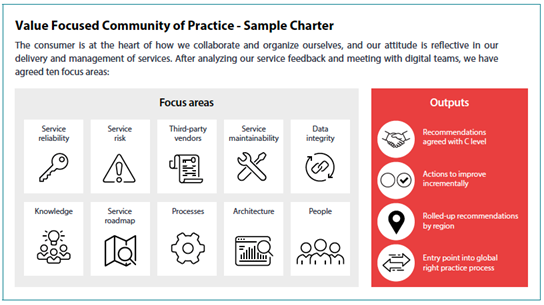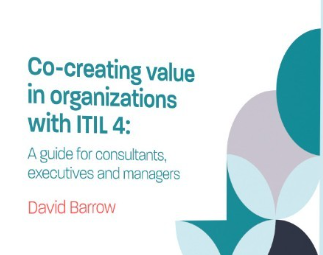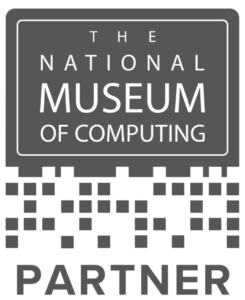IT Service Management is great, isn’t it? Surely that’s why you are reading this blog; as a member of itSMF UK you agree, its great and you get IT.
For me the truth is that as members of itSMF we surely ‘get’ IT, but how often do our colleagues, customers, and extended network get it? Just how well do we combine our expertise with that of our network of colleagues and customers and co-create real value in the design and delivery of ITSM.
I’ve heard it said before that, at its heart, good service management is built upon educated experimentation. As a collective, we have developed to a level where education, experience, membership, and an educated opinion are highly valued.
Much of this is thanks to our certification in management practices and frameworks. In addition, we also rely on our experiences to inform our decisions. In ITIL, this is referred to as ‘adopt and adapt’: the adoption, adaptation, and optimisation of ITSM within our organisations is something that is often positively encouraged – but how do we extend this approach to the co-creation of value throughout an organisation?
Over the years I have worked in teams where we do things ‘to’ customers. We’d set up policies, process and measurements and facilitate workshops where we’d tell our customers how to work, what to measure, when to meet etc. This worked well, to a degree. Programmes were signed off, invoices settled, but what difference did we really make? Did we co-create value or did we just do ‘IT’ to our customer?
Since working as a consultant in ITSM I’ve had to find a new way of doing things. Thanks to some remarkable customers I’ve been able to adopt and adapt the co-creation of value as opposed to doing things ‘to’ them.
How? One way is to create value-based Communities of Practice (COP).
Establishing a value-based Community of Practice
My first time implementing a community of practice was when engaged to focus on digital service quality within an enterprise. Our CIO and peers recognised that silos had developed across teams, geographies, and technologies, and further investigation indicated that these were proving disruptive in delivering real service quality to both the internal users and customers, diminishing service experience.
As part of our fact-finding mission, we discovered a current state where digital front-end services were developing at pace in line with the client’s vision and strategy; however, these recently developed services were often out of sync with their underpinning legacy services. Multiple management frameworks and methodologies were being implemented with varying flavours throughout the organisation, while many third-party suppliers were distanced from the business values and operating their own framework interpretations.
The net result was employees and customers expressing a dissatisfaction with services that was simply not reflected in monthly service management and C-level reviews – an example of watermelon SLAs which were done ‘to’ the organisation.
We were now in a situation where we were looking for a new approach to a familiar problem, and relied on experience and trust to provide a solution. My pitch that day, and the feeling with all that I’ve learned before and since, is that IT service management should shift its focus to the organisation, delivering digital products and services that enable the co-creation of value for service customers via a value-driven community – as opposed to just targeting IT delivery.
This began by engaging people from across the organisation and its suppliers to look at services in a more holistic way, agreeing on a joined-up approach to applying real value to the ongoing delivery and development of digital services. We took people out of their day-to-day work once a week via a value-based Community of Practice (CoP); and we built a service quality charter defining how we would co-create value.
We didn’t adopt a ‘big bang’ approach however. Working with our sponsors, we selected just a few services and teams to focus upon. We considered not only their role but also their influence, their input, and most vitally their impact on service definition, service production, and service support, along with their formal and informal interaction with service customers.
This became our stakeholder map, leading to a sustainable CoP that could influence others. Our initial group was made up of global consumer-facing teams as well as those at C level, including champions at each level who would support a continual and iterative improvement ethos.
As part of this exercise, we often found teams working in opposition to one another: differences in strategy, objectives or culture. Mostly this opposition occurred because the teams only worked ‘together’ during – or because of – stressful, urgent situations such as a major incident, a failed change, or a time-critical presentation.
To counter this we adopted an approach based on ALOE (asking, listening, observing, empathising), discovering that teams felt less restricted by working in a practice rather than ‘within’ a process.
Taking these teams out of ‘the trenches’ and into a safe environment immediately removed the stress of those situations. Each of the teams contributed to, and ultimately agreed on, a service quality charter that reflected the values of the organisation and the community, a team that grew as people sought to get involved over the coming weeks and months. Our value-based Community of Practice was born.
Example of a Community of Practice Service Quality Charter

Source: Co-Creating Value in Organisations with ITIL. Author David Barrow, published by The Stationery Office under license from PeopleCert.
Our initial community grew from a handful of members to become a global team of influencers and impactors, with a strong focus on service quality built on our own service quality charter and the company’s service values and vision.
Positive results came quickly with proof-of-concept services that the community agreed upon. We grew our understanding of the services through value-based conversations, moving onto splitting out our teams to map the current and desired state for the services, both technical and non-technical, resources, partners, measures, and governance layers.
We also set out to understand whether the services were being received well by customers, leading us to look most closely at those watermelon services that were reporting ‘green’ on a month-by-month basis yet had less than positive consumer feedback.
Not only did this community (and those that came thereafter) embed continual improvement as a practice across digital services and their lifecycle; we also identified role gaps across the organisation, set team objectives that became organisational objectives, and informed the organisation’s technology roadmap and strategy (amongst many other positive outcomes).
Over time these communities will grow as people see positive outcomes, with everyone involved invested in what we as members of itSMF would label ITSM – just without the label.
Whether they worked in HR, finance or digital and whether they were a developer, supporter or consumer of the services, each member of the community played a part in both co-creating and implementing value into digital services, in an iterative manner and feeling part of what became quite the ongoing success story.


David Barrow
David Barrow is a service management consultant and the author of Co-Creating Value in Organizations with ITIL4, published by TSO.


